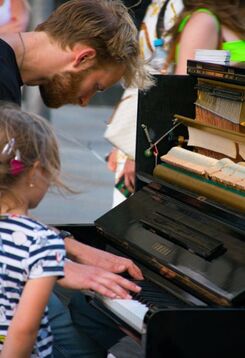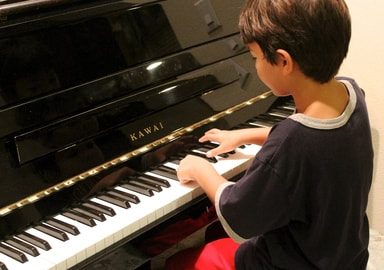San Jose Jazz Piano Teacher
Why Learn Jazz?
Lots of different people view jazz in lots of different ways, but there is one thing that we all know to be true about jazz: it is fun. For parties, if someone sits down at the piano and breaks out some jazz improv or a good piece, people start moving. You almost can't help yourself!
Not only is listening to jazz fun, but playing it, and even watching it is! Swinging rhythms and improvised arpeggiation with scales and chords being banged in each hand is why jazz is so lively and fun, and why students and teachers alike love to play it. Another interesting feature of jazz is how the player themselves looks as they play. Classical musicians often make faces and lean their bodies in all sorts of directions - this is because they are heavily feeling the emotions in the music. Jazz musicians, however, often times have a difficult time not moving and grooving to the music.
As you'll learn throughout your career in music, when your skill increases, your body reflects the feeling of the music you play more. Your arms bounce, your hands jump between notes, your head bops, and your body contorts a little bit. You'll find that whether you're improvising your own stuff or reciting someone else's, it's hard to not get groovy while playing jazz. Talk about jazz hands!
Not only is listening to jazz fun, but playing it, and even watching it is! Swinging rhythms and improvised arpeggiation with scales and chords being banged in each hand is why jazz is so lively and fun, and why students and teachers alike love to play it. Another interesting feature of jazz is how the player themselves looks as they play. Classical musicians often make faces and lean their bodies in all sorts of directions - this is because they are heavily feeling the emotions in the music. Jazz musicians, however, often times have a difficult time not moving and grooving to the music.
As you'll learn throughout your career in music, when your skill increases, your body reflects the feeling of the music you play more. Your arms bounce, your hands jump between notes, your head bops, and your body contorts a little bit. You'll find that whether you're improvising your own stuff or reciting someone else's, it's hard to not get groovy while playing jazz. Talk about jazz hands!
/
Our son is now 6 years old and only takes lessons on weekends and in spite of not being able to practice daily; he continues to progress under Shahin. Shahin motivates him to learn, memorize pieces, to follow instructions and in this matter is teaching him discipline. Irrespective of the mood Ayrton is in Shahin finds a way to turn him around and enjoy each and every lesson. Ayrton has musical happiness’ and feels like he is accomplishing something substantive because of Shahin.
|
Jazz Improvisation Lessons
Whereas classical music tends to emphasize reading, jazz is all about listening. This importance on listening is key to improv in jazz, one of its most definable features. Improvisation is one of those skills that many people consider impossible without highly developed musicianship or natural musical genius.
We at San Jose Piano Lessons know this to be untrue, seeing people of all sorts come from no musical knowledge to being able to improvise rhythmic, groovy pieces! In order for our students to achieve a level of improvisation that satisfies, we focus on their knowledge of scales, arpeggios, and a couple other key features of jazz piano (and piano in general).
We at San Jose Piano Lessons know this to be untrue, seeing people of all sorts come from no musical knowledge to being able to improvise rhythmic, groovy pieces! In order for our students to achieve a level of improvisation that satisfies, we focus on their knowledge of scales, arpeggios, and a couple other key features of jazz piano (and piano in general).
The History of Jazz Piano
Jazz, like almost all music, was built upon previous forms of music, namely ragtime. Ragtime, like jazz, was first invented in America, in 1899, by Scott Joplin (think pieces like "The Entertainer" and "Maple Leaf Rag"). Included in ragtime were certain aspects rarely seen in piano before, but now easily recognizable as key features of jazz, namely those of syncopation and "swing" rhythms. Syncopation is where notes are placed outside of the "pulse," which is more or less the beat that you are compelled to bob your head and tap your foot to.
This outside placement makes pieces sound offbeat, creating interesting but satisfying tension in pieces and improvisations. Swing rhythms are rhythms that you can basically think of as having "musical momentum" (there are similar situations in classical music, but the term "swing" is not typically used in describing this style of music) that you want to sway or swing your body to while listening and playing. This, as well as syncopation, are some of the traits of ragtime and jazz that are almost instant identifiers of those types of music.
Another term used to describe similarly-unique features are stride. While there have been many changes and additions to what's known today as jazz, the loud-but-light sound, the jolty, swinging, or striding expressions, and the seemingly misplaced, syncopated notes have been core qualities extended through its entire history.
This outside placement makes pieces sound offbeat, creating interesting but satisfying tension in pieces and improvisations. Swing rhythms are rhythms that you can basically think of as having "musical momentum" (there are similar situations in classical music, but the term "swing" is not typically used in describing this style of music) that you want to sway or swing your body to while listening and playing. This, as well as syncopation, are some of the traits of ragtime and jazz that are almost instant identifiers of those types of music.
Another term used to describe similarly-unique features are stride. While there have been many changes and additions to what's known today as jazz, the loud-but-light sound, the jolty, swinging, or striding expressions, and the seemingly misplaced, syncopated notes have been core qualities extended through its entire history.


